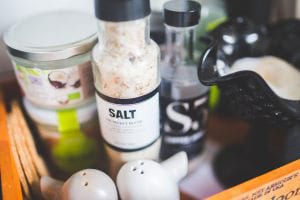For some cases of dysautonomia, doctors suggest increasing the salt intake in your diet. Doing so may help raise your blood pressure to alleviate light headedness, and improve fatigue level and concentration. Some people take salt tablets or drink electrolyte drinks.
But YOU can be much more hip about it, because salt is a hot topic in the foodie world!
Here are some trendy salts you might want to try:

First, there’s the classic Fleur de Sel, or “flower of salt.” Fleur de sel is hand-harvested from salt beds off the northern Atlantic coast of France. The water is purposefully routed into shallow marshes and allowed to begin evaporating. The fragile salt crystals rise to the surface and are gently raked into mounds for collection. Fleur de sel’s high moisture content means it lingers on your tongue—yummy!
This stuff’s expensive, but, hey, if you have to deal with dysautonomia, shouldn’t you treat yourself (literally) every once in a while?
If your wallet isn’t up for such a big splurge, there are other sea salts to try, from the slightly pink-tinged Himalayan to the lava-black salts of Hawaii. You can get sea salts that have other ingredients mixed in, such as Italian truffles or fiery ghost peppers. There’s even salt infused with alderwood smoke. One popular salt among foodies is the flaky Maldon salt—they love its wonderful crunchy crystals.
If you want to try salts that aren’t recently derived from seawater, you still have great options.

Kosher salt and different types of table salt come from inland rock-salt deposits, which are really just ancient seabeds. Kosher salt has a coarse grain. It’s called kosher, not because it’s evaporated following any special religious rules, but because it was traditionally used to remove blood from meat (which is a religious rule some people follow) in a process called koshering.
All salts that aren’t harvested from fresh seawater are mined by pumping water into an underground salt deposit. That dissolves the salt into the water, which is then pumped to the surface and “vacuum evaporated,” leaving the tiny grains we shake out of our salt shakers.
You can find specialty salts by searching “gourmet salts” or “artisanal salts”—they’re available on Amazon and through many different websites. If you want to geek out some more about these simple grains, you can read the book Salt: A World History, by Mark Kurlansky.
And if you want to learn more about dysautonomia—and connect with other people who have it—visit the Dysautonomia International website.
Have you made food choices that have helped you deal with your dysautonomia symptoms? Share your recipes or ideas in the comments!






